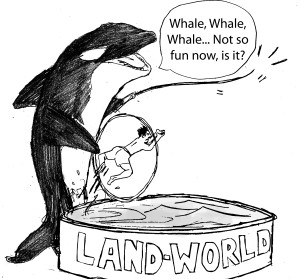Animal Cruelty in Aquatic Parks
March 11, 2014

SeaWorld: home to several aquatic shows, family fun and according to a recent documentary, animal cruelty.
Orlando, Florida hosts to one of the three SeaWorld locations, and is a popular destination for many students and their families during spring break because of their glorified killer whale shows.
SeaWorld, along with many other organizations, brings animals into captivity to preform unnatural tasks in unnatural habitats. This leads them to live atypical lives which sacrifices the freedom and mental stability the animals would have in the wild.
“I think that the only thing we’ve learned from having these a�� or one of the most important things we’ve learned from having these animals in captivity, is that they’re not suitable to have in captivity,” former SeaWorld trainer Carol Ray said in a live CNN report. Ray was responding to the popular documentary “Blackfish,” that was released on Netflix July 19, 2013.
According to “Blackfish,” the relationships the trainers have with the whales are commercialized and solely for entertainment purposes. SeaWorld management may distort facts about the physicality and emotions of their whales. The star of SeaWorld, Tilikum, killed three of his trainers, most recently Dawn Brancheau, perhaps due to his frustration from being confined. These killings have never been listed in his profile as to not scare trainers.
Regardless of the entertainment and educational value the killer whales provide at SeaWorld, the amount of stress that has come to the killer whales is extraordinary. “I don’t like how such big animals are trapped in a tank,” sophomore Laura Kjellman said. “But I can see why they keep [having shows]a��it brings in money.” The killer whales at SeaWorld are left psychologically traumatized by being left in tanks just big enough for their bodies.
On the other hand, marine parks do give people of all ages the opportunity to be up close and personal to wild animals and observe their lifestyle. “I don’t think it’s too bad to have [whales] in captivity. I think it stands to educate a lot of people and it can raise conservation efforts and money for animal resources out in the wild,” biology teacher Jeff Grandin said.
It is easy to create an artificial environment for these animals to live in to help them feel more “at home.” However, no place will grant any animal the freedoms it needs to sustain a decent life like in the wild.



